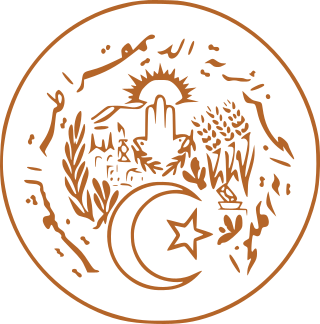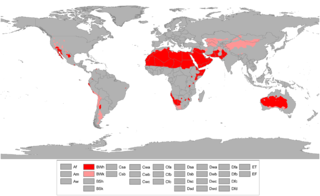
El Oued, Souf or Oued Souf is a city, and the capital of El Oued Province, in Algeria. The oasis town is watered by an underground river, hence its name is El Oued which enables date palm cultivation and the rare use of brick construction for housing. As most roofs are domed, it is known as the "City of a Thousand Domes".
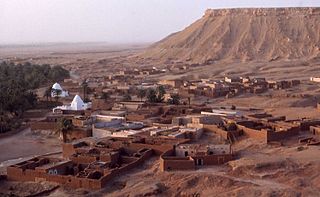
El Goléa is an oasis town and commune, and capital of El Ménia District, in Ghardaïa Province, Algeria. The official name is El Ménia ; together in Arabic, the two names mean Impregnable Castle. According to the 2008 census it has a population of 40,195, up from 28,848 in 1998, with an annual growth rate of 3.4%. The area is inhabited by the Zenete Berbers. El Goléa oasis grows many agricultural products. The grave of the French priest Charles de Foucauld is located in the town.

Illizi is a town and commune, coextensive with Illizi District, situated in the south-eastern part of Algeria, and capital of Illizi Province. According to the 2008 census it is the largest commune by population in the province, with a population of 17,252, up from 10,163 in 1998, and an annual population growth rate of 5.5%, the highest in the province. It is one of the gates to the Tassili N'Ajjer National Park with caves situated under the sands containing prehistoric drawings dating from 6000 years BC. There is a hotel and two camping sites, as well as many local tourist agencies.
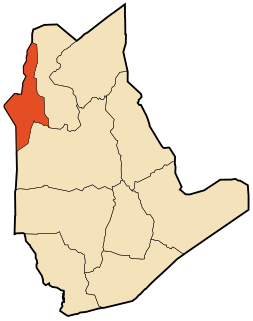
In Ghar is a town and commune, coextensive with the district of In Ghar, in Tamanrasset Province, Algeria. According to the 2008 census it has a population of 11,225, up from 8,059 in 1998, with an annual growth rate of 3.4%. Its postal code is 11210 and its municipal code is 1103.

Aougrout is a commune in Aougrout District, Adrar Province, in south-central Algeria. According to the 2008 census it has a population of 11,784, up from 9,878 in 1998, with an annual growth rate of 1.8%.

Tsabit is a town and commune, and capital of Tsabit District, in Adrar Province, south-central Algeria. According to the 2008 census it has a population of 14,895, up from 11,832 in 1998, with an annual growth rate of 2.4%.
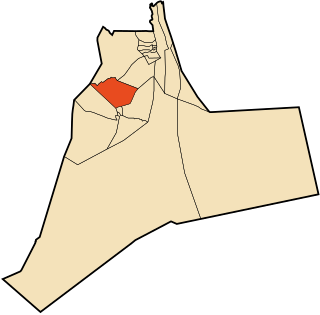
N'Goussa is a town and commune, coextensive with the district of the same name, in Ouargla Province, Algeria. Some of its inhabitants speak the Ouargli language. As of 2008, the population of the town was 19,039, up from 13,344 in 1998, with an annual population growth rate of 2.2%. The town is on a local road, about 20 kilometres (12 mi) north of Ouargla on the way to El Hadjira further north.

Djamaa is a town and commune in El Oued Province, Algeria. According to the 2008 census it has a population of 50,916, up from 37,438 in 1998, with an annual growth rate of 3.1%.

Magrane is a town and commune, and capital of Magrane District, in El Oued Province, Algeria. According to the 2008 census it has a population of 24,577, up from 20,102 in 1998, with an annual growth rate of 2.1%.

Nakhla is a town and commune in Robbah District, El Oued Province, Algeria. According to the 2008 census it has a population of 12,652, up from 9,491 in 1998, with an annual growth rate of 3.0%.
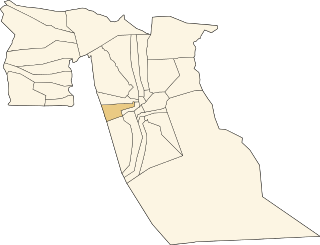
Ourmes is a town and commune in Guemar District, El Oued Province, Algeria. According to the 2008 census it has a population of 5,900, up from 5,059 in 1998, with an annual growth rate of 1.6%. It is located 9 kilometres (5.6 mi) northwest of the provincial capital El Oued, and is connected by local roads to Kouinine and Taghzout.

Robbah is a town and commune, and capital of Robbah District, in El Oued Province, Algeria. According to the 2008 census it has a population of 21,965, up from 17,243 in 1998, and an annual growth rate of 2.5%. The town lies about 10 kilometres (6.2 mi) southeast of the provincial capital El Oued and forms a part of its larger urban area.

Sidi Khellil is a town and commune in El M'Ghair District, El Oued Province, Algeria. According to the 2008 census it has a population of 6,547, up from 5,524 in 1998, and an annual growth rate of 1.7%.

El Guerrara is a town and commune, coextensive with El Guerrara District, in Ghardaïa Province, Algeria. According to the 2008 census it has a population of 59,514, up from 48,313 in 1998, with an annual growth rate of 2.1%.

Ain Beida is a town and commune in Sidi Khouïled District, Ouargla Province, Algeria. According to the 2008 census it has a population of 19,039, up from 14,500 in 1998, and an annual population growth rate of 2.8%. Ain Beida is just 6 kilometres (3.7 mi) from central Ouargla and is effectively a suburb of the city. It is also home to the Ain Beida Airport, Ouargla's principal airport.

Megarine is a town and commune in Ouargla Province, Algeria, located just north of the city of Touggourt. According to the 2008 census it has a population of 13,751, up from 10,996 in 1998, and an annual growth rate of 2.3%.

M'Naguer is a town and commune in Taibet District, Ouargla Province, Algeria. According to the 2008 census it has a population of 14,179, up from 11,243 in 1998, and an annual population growth rate of 2.4%.

Sidi Slimane is a town and commune in Mégarine District, Ouargla Province, Algeria, located near the city of Touggourt. According to the 2008 census it has a population of 8,072, up from 6,822 in 1998, and an annual growth rate of 1.7%.

Taibet is a town and commune, and the capital of Taibet District, in Ouargla Province, Algeria. According to the 2008 census it has a population of 20,174, up from 14,322 in 1998, and a growth rate of 3.6%.
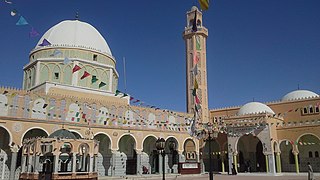
Tamacine is a town and commune, and capital of Témacine District, in Ouargla Province, Algeria. According to the 2008 census it has a population of 20,067, up from 15,933 in 1998, and an annual growth rate of 2.4%. It is around 10 kilometres (6.2 mi) south of Touggourt. The Tugurt language is spoken by some residents of Tamacine.

